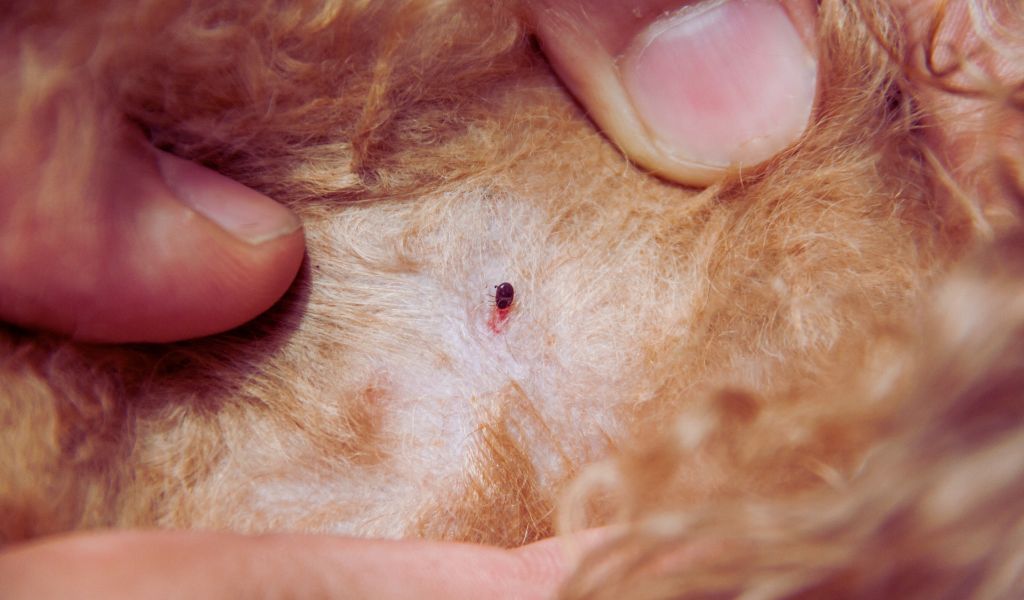Winter often brings relief from many pests, but surprisingly, fleas can still pose a problem during the colder months.
This article explores the resilience of fleas in winter, their impact on dogs, and effective strategies for prevention and treatment.
It’s an essential read for pet owners seeking to protect their furry friends year-round from these pesky parasites.

About Fleas in Winter
Contrary to popular belief, fleas do not completely die off during the winter months. Instead, they adapt to survive in colder climates, often finding refuge in warm and humid environments like our homes.
This adaptability allows fleas to continue their life cycle year-round, posing a continuous threat to pets and their owners.
Can Dogs Really Get Fleas in Winter?
Yes, dogs can and do get fleas in winter. The assumption that fleas die off or become dormant during cold months is a common misconception. Fleas can thrive in the controlled climates of our homes, making winter as risky as summer for flea infestations.
How Do Fleas Survive the Cold Winter Months?
Fleas survive winter by exploiting warm environments. Inside homes, central heating provides an ideal breeding ground.
Adult fleas, larvae, and even eggs can live comfortably in the warm fibres of carpets, bedding, and upholstery, making it crucial to maintain flea control measures throughout the year.
Identifying a Flea Infestation in Winter
Spotting a flea infestation during winter involves observing your dog for signs of discomfort, such as excessive scratching, red or irritated skin, and the presence of flea dirt.
Regular use of a flea comb can help catch an infestation early before it becomes more challenging to manage.

The Life Cycle of Fleas During Winter
Understanding the flea life cycle is key to controlling infestations.
Even in winter, fleas can progress from eggs to adults in just a few weeks if conditions are right.
The lifecycle of fleas on dogs can be broken down into four main stages: egg, larva, pupa, and adult.
This cycle is essential to understand for effective flea control and prevention.
Below is a detailed table that outlines each stage of the flea lifecycle in dogs:
| Stage | Description | Duration |
|---|---|---|
| Egg | – Fleas lay eggs on the host (dog) after feeding on its blood. | – 1 to 10 days |
| – Eggs are white, oval-shaped, and very small, easily falling off the host into the environment. | ||
| Larva | – Eggs hatch into larvae which avoid light and feed on organic debris and adult flea faeces. | – 5 to 20 days |
| – Larvae are blind and will move away from light, burrowing into carpets, cracks, or soil. | ||
| Pupa | – Larvae spin silk-like cocoons to become pupae. | – 7 days to several months |
| – Pupae are the transitional stage to adulthood, and this stage can be prolonged for months. | ||
| – The emergence of adult fleas from the pupae is triggered by vibrations, heat, and carbon dioxide, indicating the presence of a host. | ||
| Adult | – Once emerged, adult fleas seek a host to begin feeding on blood within hours. | – Lifespan of 2 weeks to several months |
| – Adult fleas will mate and reproduce on the host, perpetuating the flea lifecycle. |
The duration of each stage can vary significantly depending on environmental conditions, such as temperature and humidity.
Warmer conditions can accelerate the flea lifecycle, making year-round flea prevention important for pet owners.
Preventing Winter Flea Infestations
Prevention is always better than cure when it comes to fleas.
Year-round flea prevention treatments for your pet, regular cleaning and vacuuming of your home, and treating areas where pets sleep can greatly reduce the risk of winter flea infestations.
Effective Flea Treatments for Dogs in Winter
If your dog does get fleas in winter, there are several effective treatments available.
Topical flea treatments, oral medications, and flea shampoos can eliminate active infestations.
Consult with your veterinarian to choose the safest and most effective treatment for your pet.

Home Remedies vs Professional Treatments
While some home remedies may offer temporary relief from fleas, professional treatments are generally more effective at fully eradicating infestations.
Professional products tend to have longer-lasting effects and are formulated to target fleas at every stage of their life cycle.
The Importance of Year-Round Flea Prevention
Maintaining flea prevention measures throughout the year is crucial to keeping your pets and home flea-free.
This includes regular treatments for your pets, cleaning your home frequently, and being vigilant about potential flea carriers entering your home.
Common Myths About Fleas in Winter
Several myths surround fleas and winter, such as the belief that fleas cannot survive freezing temperatures or that indoor pets are not at risk.
Dispelling these myths is important for understanding the true nature of flea behavior and ensuring effective prevention and treatment strategies.
Key Points
Fleas can survive and thrive in winter, especially in warm indoor environments.
Regular flea prevention treatments for pets are crucial year-round.
Identifying and treating flea infestations early can prevent them from becoming more severe.
Professional flea treatments are generally more effective than home remedies.
Dispelling common myths about fleas can lead to better prevention and treatment strategies.
Understanding the resilience of fleas in winter and implementing effective control measures can protect your pets and your home from these persistent parasites.
FAQ: Can Dogs Get Fleas in the Winter?
1. Can dogs get fleas in the winter?
Yes, dogs can get fleas in the winter. While it’s a common misconception that fleas are only a problem in warmer months, they can survive indoors during the winter and infest your dog.
2. Do fleas die in the cold winter months?
Although cold temperatures can slow down flea activity, most fleas can survive indoors during winter months where it’s warm. They may not thrive as well in the cold, but they can still be a nuisance.
3. How can I prevent fleas on my dog in winter?
To flea control in the winter, continue with regular preventive treatments. Consult your veterinarian for the best options to protect your dog against fleas and ticks year-round.
4. Can I treat my dog for fleas during the winter?
Absolutely, it’s important to treat your dog for fleas throughout the winter months. Fleas can lay eggs and continue their life cycle even in cold weather. Use vet-recommended flea prevention methods.
5. Are dogs still susceptible to flea infestation in winter?
Yes, dogs are still at risk of getting fleas in winter. Your home, especially with central heating, can create a warm breeding ground for fleas. Preventative measures are crucial to avoid flea infestation year-round.
6. Do fleas thrive in the winter?
While fleas prefer warmer conditions, they can still survive and multiply indoors throughout the winter. Regularly assess your pets and surroundings for any signs of flea populations to prevent an infestation.
7. How do I find out if fleas are present on my dog in winter?
Look for signs like excessive scratching, flea bites on your dog, or even the presence of flea dirt (feces) on their fur. If in doubt, consult your veterinarian to check for fleas and prevent further infestation.




